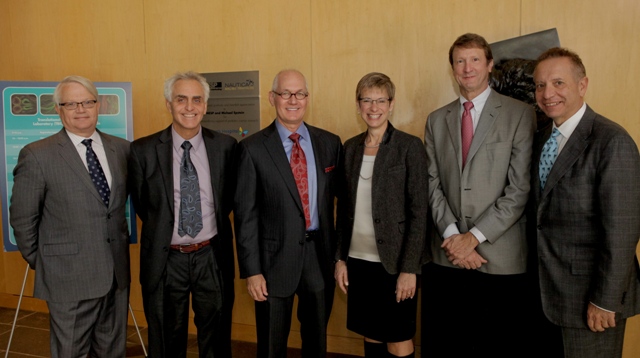Nov 22 2013
With the launch of the Translational Biomedical Imaging Lab (TBIL), investigators at The Saban Research Institute of Children’s Hospital Los Angeles and their colleagues at the University of Southern California moved us closer to a day when disease can be treated before symptoms become apparent.
TBIL, a combination of technology and intellectual infrastructure, brings together a team of interdisciplinary scientists to leverage strengths across disciplines and campuses.
 From left to right: Marvin Nelson, MD, MBA, Rex Moats, PhD, Brent Polk, MD, Elizabeth Garrett, JD, Scott Fraser, PhD, Carmen Puliafito, MD, MBA
From left to right: Marvin Nelson, MD, MBA, Rex Moats, PhD, Brent Polk, MD, Elizabeth Garrett, JD, Scott Fraser, PhD, Carmen Puliafito, MD, MBA
TBIL is a unique, interdisciplinary collaboration that combines dynamic imaging equipment, including a state-of-the-art laser scanning microscope, with an intellectual infrastructure of optical physicists, computer scientists, translational researchers and clinicians. This combination of interdisciplinary expertise and equipment capable of imaging at the molecular level, will allow an unprecedented view of congenital conditions and disease states before symptoms are apparent. Along with this unique view into the very beginnings of compromised health, comes the capability to intervene at the earliest possible time – prior to outward signs of the condition or symptoms of the disease.
“Imaging has become the Rosetta stone of research by allowing investigators access to disease at the most basic, molecular level,” said Scott Fraser, PhD, provost professor of Biological Sciences, Biomedical Engineering and Pediatrics, and TBIL co-director. “TBIL provides equipment and trained talent in order to accelerate the trajectory of scientific discovery from the bench to the bassinette to the bedside.” Fraser shares co-directing responsibilities with Rex Moats, PhD, of The Saban Research Institute.
With TBIL resources, an investigator can follow the cells of a developing organ and see when and how a congenital defect occurs – providing an opportunity to intervene and change the outcome. The cost of congenital defects is significant – both in terms of human potential and healthcare dollars. Heart defects are the most common birth defects in the United States, affecting approximately 40,000 babies each year. The Centers for Disease Control estimates that nearly 1 million adults in the U.S. are living with a congenital heart defect and the annual cost of hospitalization exceeds $1 billion.
“With the joint recruitment of Dr. Scott Fraser to Children’s Hospital and USC, we have been able to put this amazing imaging resource in place,” said Brent Polk, MD, director of The Saban Research Institute, chairman of Pediatrics and vice dean for Child Health at the Keck School of Medicine of USC. “TBIL will help accelerate both the diagnosis and treatment of health issues that have significant impact on children and the adults they will become.”
During the launch event at The Saban Research Institute, attendees traveled around the building, accessing the various spaces that constitute TBIL, including:
- The “Collaboratory” –interaction space with high resolution video and video conferencing capabilities
- Live Imaging Lab – with a multi-spectral, multi-photon microscope for high-resolution imaging of living specimens
- High Speed Microscopy Lab – offering high-speed, volumetric imaging
- Extended Volume Imaging Lab – providing an integrated microtome and laser-scanning microscope for imaging large specimens
- Quantitative Image Analysis and Visualization Suite – providing high resolution workstations for image processing and image analysis
At the launch event, the inter-institutional collaboration was highlighted by the attendance of Polk, Elizabeth Garrett, JD, provost of the University of Southern California and Carmen Puliafito, MD, MBA, dean of the Keck School of Medicine of USC.
“Reaching across campuses, we continue to invest in the intellectual convergence of medicine, chemistry and engineering to improve clinical care for children in our community,” said Garrett. “USC and Children’s Hospital Los Angeles are committed to developing world-class research facilities such as TBIL that provide flexibility for our faculty to collaborate as they address complex health problems.”